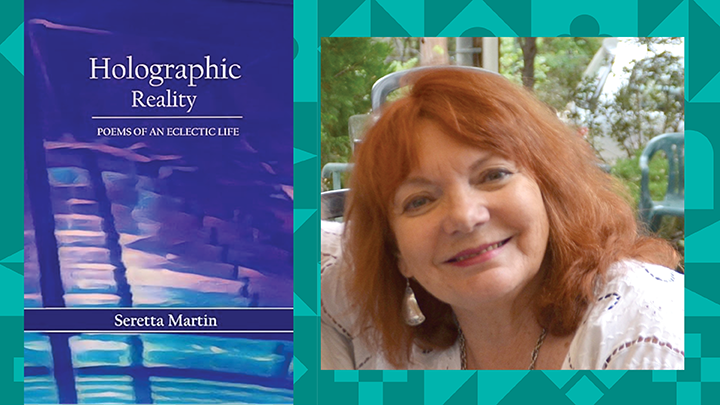It’s all about the people: alumna Seretta Martin talks publishing and poetry
People are at the heart of MFA in creative writing alumna’s second book of poetry.

Seretta Martin, a published poet and visual artist, graduated from San Diego State University in 2013 with an MFA in creative writing and a B.S. in video, film, and educational technology. Prior to attending SDSU, she received art training from the Chouinard Art Institute in Los Angeles where, in the late 1920s, Walt Disney sent his inexperienced animators for training.
Martin has now published two poetry collections, “Foreign Dust Familiar Rain: New and Selected Poems” in 2003 and her most recent book, “Holographic Reality: Poems of An Eclectic Life,” in July. Her work has been published in anthologies and journals here and abroad.
Although Martin acquired many invaluable resources while obtaining her MFA, her introduction to the world of poetry began before her time in the program. Martin was inspired to take up poetry in 1999 after a conversation in a piano bar with Jack Webb (founder of the Border Voices Poetry Project and ‘95 alumnus of the MFA in creative writing). “Quite often, somebody you meet can be a life changer,” Martin said.
Martin’s interest in poetry solidified through her experiences in the Border Voices Poetry and California Poets in the Schools projects. Alongside this, Martin began taking her mother — also a poet and artist — to workshops to keep her connected to poetry after losing many friends and colleagues in her network.
“I think you have to have a community,” Martin said. “If you're working in a vacuum, you don't meet people that you can help or that can help you. You don't make the connections you need to make [in order] to move forward.”
Martin entered the MFA program as an over-60 student, expanding her circle of support and inspiration. She said that “it was very exciting to be back in the academic world,” going on to list the many people who made her time at SDSU such a warm, once-in-a-lifetime experience. It is clear in her stories that it is all about the people for Martin, acting as both her ‘why’ and ‘how’ when it comes to poetry.
Martin embarked on publishing her work after a conversation with an acquainted professor at Idyllwild Arts Academy. “One of the things [he] said was that it was no longer considered a vanity press to publish your own work,” she said. “The publishing industry had changed a lot at that point. It was totally acceptable to publish your own work. So I thought, ‘That's kind of cool. I think I'll try it.’ I've stepped up to the challenge.”
The publishing industry is fluid — evolving with society as any business might. While the fluidity may bring about productive changes, such as collapsing negative associations with self-publishing, it also presents new challenges. Martin said, “Back then (2003), you had to meet with a printer and work with them face-to-face on all the different aspects of the book. Now, you're doing it on your own computer and compiling a manuscript.” Martin believes the process has become streamlined while also becoming more technically challenging.
The fast-paced and significant shifts characterizing the publishing industry have not prevented Martin from adapting. Her first book consists of her visual and written art. Martin spent the last 20 years honing and refining her skills for her second publication, which includes 125 free verse, sonnet, narrative, lyrical haiku, haiku sequence, haibun (prose and haiku combination), senryu (haiku about human nature), and monoku (single line haiku) poems.
When asked how she approaches such extensive writing projects, Martin describes her writing process as a mixed bag. She began with analog writing tools like a classic, yellow ledger pad, using digital tools solely for editing and finalizing; however, she gradually moved toward using the computer at earlier stages in the writing process as digital options became more convenient and accessible. Regardless, one might find written notes on random pieces of paper sprinkled around her house to this day — capturing moments when inspiration struck.
Martin’s inspiration, unsurprisingly, can be attributed to people and their humanity. She said that her writing follows themes of love and themes of compassion. Her poems range in topic from strong women survivors, to victims of war or PTSD, to artist portraits, to surrealism pieces. “I've met so many people that I really enjoy through poetry,” she said. This is where Martin draws her inspiration and what, ultimately, ties her writing together.
With two poetry collections under her belt, Martin shows no signs of exhausting her creativity. She is working on her next publication, “Silkworms in the Attic,” inspired by ancient Chinese and Japanese poets, Zen philosophy, and the love of home and family — set to arrive later this year.
When she is not preparing for her next book release, Martin teaches online and in person for the Oasis Learning Center; San Diego Writers, Ink; California Poets in the Schools; and the Border Voices Poetry Project. “My life is so full with teaching and poetry — and I love it that way,” she said.
People are the lifeblood of Martin’s writing, just as they are the heart of her story. As long as the world is full of intriguing individuals and admirable artists, she has access to a life of not only teaching and poetry but the inspiration to continue both.
